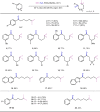Photo-mediated selective deconstructive geminal dihalogenation of trisubstituted alkenes
- PMID: 32901002
- PMCID: PMC7479597
- DOI: 10.1038/s41467-020-18274-2
Photo-mediated selective deconstructive geminal dihalogenation of trisubstituted alkenes
Abstract
Selective deconstructive functionalization of alkenes, other than the well-established olefin metathesis and ozonolysis, to produce densely functionalized molecular scaffolds is highly attractive but challenging. Here we report an efficient photo-mediated deconstructive germinal dihalogenation of carbon-carbon double bonds. A wide range of geminal diiodoalkanes and bromo(iodo)alkanes (>40 examples) are directly prepared from various trisubstituted alkenes, including both cyclic and acyclic olefins. This C=C cleavage is highly chemoselective and produces geminal dihalide ketones in good yields. Mechanistic investigations suggest a formation of alkyl hypoiodites from benzyl alcohols and N-iodoimides, which undergo light-induced homolytic cleavage to generate active oxygen radical species.
Conflict of interest statement
The authors declare no competing interests.
Figures







Similar articles
-
Taking Olefin Metathesis to the Limit: Stereocontrolled Synthesis of Trisubstituted Alkenes.Acc Chem Res. 2023 Sep 19;56(18):2426-2446. doi: 10.1021/acs.accounts.3c00341. Epub 2023 Aug 29. Acc Chem Res. 2023. PMID: 37643361
-
Deconstructive diversification of cyclic amines.Nature. 2018 Dec;564(7735):244-248. doi: 10.1038/s41586-018-0700-3. Epub 2018 Oct 31. Nature. 2018. PMID: 30382193 Free PMC article.
-
Synthesis of trisubstituted alkenes via olefin cross-metathesis.Org Lett. 1999 Dec 2;1(11):1751-3. doi: 10.1021/ol991023p. Org Lett. 1999. PMID: 10836036
-
Radical-Promoted C-C Bond Cleavage: A Deconstructive Approach for Selective Functionalization.Angew Chem Int Ed Engl. 2019 Oct 1;58(40):14044-14054. doi: 10.1002/anie.201905218. Epub 2019 Jul 26. Angew Chem Int Ed Engl. 2019. PMID: 31168934 Review.
-
Recent advances in chelation-assisted site- and stereoselective alkenyl C-H functionalization.Chem Soc Rev. 2021 Mar 15;50(5):3263-3314. doi: 10.1039/d0cs00447b. Chem Soc Rev. 2021. PMID: 33491691 Review.
Cited by
-
Deconstructive Functionalization of Unstrained Cycloalkanols via Electrochemically Generated Aromatic Radical Cations.Org Lett. 2023 Mar 10;25(9):1486-1490. doi: 10.1021/acs.orglett.3c00219. Epub 2023 Feb 27. Org Lett. 2023. PMID: 36847269 Free PMC article.
-
Nickel catalyzed multicomponent stereodivergent synthesis of olefins enabled by electrochemistry, photocatalysis and photo-electrochemistry.Nat Commun. 2022 Jun 10;13(1):3240. doi: 10.1038/s41467-022-30985-2. Nat Commun. 2022. PMID: 35688818 Free PMC article.
-
Visible-Light-Mediated Ring-Opening Geminal Dibromination of Alkenes via Alkoxy Radicals Enabled by Electron Donor-Acceptor Complex.Molecules. 2024 Jul 11;29(14):3281. doi: 10.3390/molecules29143281. Molecules. 2024. PMID: 39064859 Free PMC article.
References
-
- Hoveyda AH, Evans DA, Fu GC. Substrate-directable chemical reactions. Chem. Rev. 1993;93:1307–1370.
-
- Grubbs RH, Chang S. Recent advances in olefin metathesis and its application in organic synthesis. Tetrahedron. 1998;54:4413–4450.
-
- Vasseur A, Bruffaerts J, Marek I. Remote functionalization through alkene isomerization. Nat. Chem. 2016;8:209–219. - PubMed
-
- Dong Z, Ren Z, Thompson SJ, Xu Y, Dong G. Transition-metal-catalyzed C–H alkylation using alkenes. Chem. Rev. 2017;117:9333–9403. - PubMed
Publication types
LinkOut - more resources
Full Text Sources

